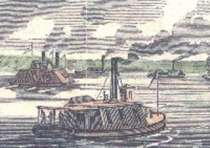
Used by both sides during the war, it was a trading center until 1864, when Gen. Nathan Forrest began an assault on April 12.
This Civil War earthwork and battleground occupies a Mississippi River bluff in Lauderdale County. Late in the spring of 1861 Confederate troops built a battery at the site to control a bend in the river. Major General Gideon Pillow subsequently ordered the construction of a 30-acre enclosure with numerous batteries below, in, and atop the bluff.
When upriver defenses crumbled in early 1862, Brigadier General John Villepigue arrived with reinforcements and a ram fleet to prepare the fort for action. Several skirmishes took place, but as a result of the Confederate retreat from Corinth, Villepigue evacuated the fort by June 4.
The Federal army irregularly used the site until fall 1862, when it became a trading center as well as a refuge for runaway slaves and Unionists. The fort held some 300 inexperienced white Unionists and approximately an equal number of African Americans, when 1500 Confederate veterans under Major General Nathan B. Forrest assaulted the fort on April 12. The gunboat evacuated most civilians and ineffectually shelled the enemy. During morning fighting, the Federals retreated to a small inner fort near the bluff.
Calling a truce, Forrest offered to accept the entire garrison as prisoners of war, a significant gesture as the Confederacy did not officially recognize blacks as legitimate soldiers. The Federals refused, and the next Confederate charge broke into the fort. Discipline among the victors broke down, and many granted no quarter. Deaths totaled 64 percent of the black troops and at least 31 percent of the whites. Forrest alleged that the Federals refused to surrender until most had died; Federal survivors claimed that a massacre took place.
Sharp Northern criticism included a congressional report written by Senator Benjamin F. Wade and Representative Daniel W. Gooch. Abandoned after the incident, the site slowly reverted into a wilderness. In 1971 the state acquired it to develop a state historical site known now as the Fort Pillow State Historic Area.
Tools
Key Facts
- 1,500 Confederate veterans under General Nathan B. Forrest assaulted the fort. A gunboat evacuated most civilians and ineffectually shelled the enemy.
- The Federals refused to surrender, and what has been called a massacre ensued.



